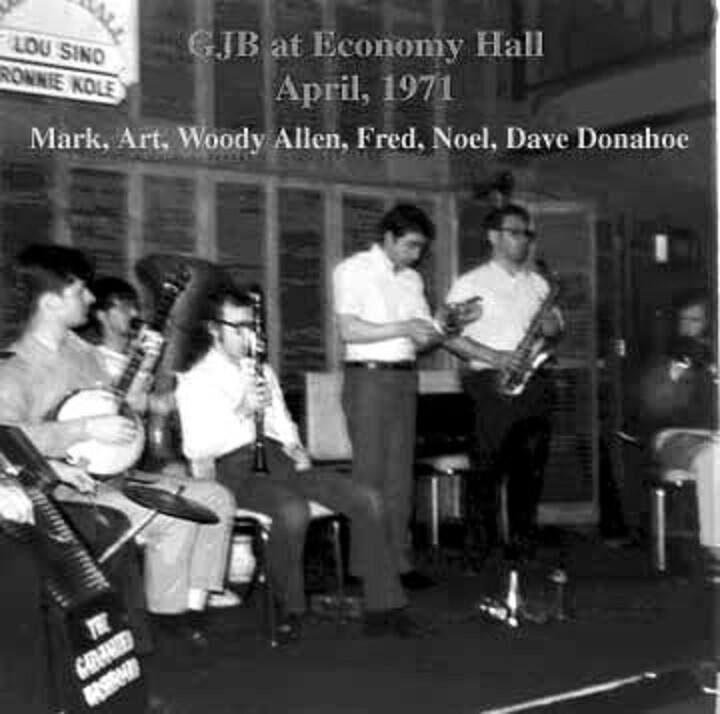Although I had wanted to play dixieland jazz since I was very young, my first opportunity did not come until the fall of 1961. Wild Bill Davison and Brad Terry were giving an outdoor concert in a Yale courtyard with a pickup band organized by Neil Waterman. I didn’t have the money for admission, so I just showed up carrying my tuba and was admitted without question. I set the tuba down on the grass and sat back to enjoy the music. After a few tunes Davison spotted the tuba and invited me to sit in, as they had no bass player. I had no idea what to do when they asked me to solo, but had a great time and nobody seemed to mind.
Shortly after that I met Bob Dunn, a classmate. Bob could play the “Maple Leaf Rag” equally well in Ab or Bb. Just for fun I asked him if he could play the left hand part in Ab while doing the right hand in Bb. He said he had never tried, but then sailed right into it. He remarked that the first part sounded like Honnegger, but the rest sounded “like a doorknob.” I helped Bob round up some musicians (Ralph Faville on trumpet, Bob Flanigan on clarinet, Howard Vidal on trombone, and Mike Waterman on drums) and we started a band which was quite popular on the campus for a time. Ralph and Bob were recruited from the Yale Band, and Howard was a brilliant trombonist still in high school.
On one occasion when we couldn’t get a drummer for a job on Long Island Ralph suggested calling George Wettling in Manhattan. Much to our amazement George said he would be happy to take a day off from his regular trio gig in a strip joint. We all squeezed into the only car we could borrow, drove to Manhattan, picked up George, and drove out to the gig. When we arrived George was having an insulin reaction. Somebody found him a popsicle while we assembled his drum set and after that the job went very well. On the way back he entertained us with stories about Wild Bill, some of which have never been published.
Around that time (1962-63) Bob Dunn heard about a local New Orleans style band called the “Easy Riders,” run by Bill Bissonette. We went to hear them at a local coffeehouse, and I remember being impressed by Noel Kaletsky on clarinet and Bill Sinclair on piano. Bill and Noel worked with us occasionally from that time on.
In the spring of 1965 I got a call from Bill Wellcome, an older banjo player who did a lot of sing-along work in the area, asking me to do a Saturday night with a new band at a place called Good-Time Charlie’s in North Haven. He told me that Noel would be on the job, and that there would be a fine young cornetist named Fred Vigorito who had recently started working with the Easy Riders. He arranged for Fred to pick me up and drive me and my tuba to the job. It was a great place for a band to play; there was a big dance floor in front of the stage, tables all around the sides and back of the room, and a balcony that went around three sides of the room. Fred’s big number in those days was Clyde McCoy’s version of “Sugar Blues.” Howard Vidal was on trombone, and the job was so important to him that he drank only coca-cola. (That’s something I had never seen before.) Eventually I was invited to return to Good-Time Charlie’s on a regular weekly basis, and that’s where I first met Sammy Rimington, who had just moved to Connecticut after some time in New Orleans.
Unfortunately, good things rarely last. As spring turned into summer and the management struggled to obtain a liquor license, the crowds began to diminish. Finally, on the Saturday night of the fourth of July weekend nobody came except Fred Vigorito’s ever-loyal family; that was the end of Good-Time Charlie’s.
When autumn arrived Eli Newberger started organizing weekly jam sessions at the International House, a residence for foreign graduate students. During his undergraduate years at Yale Eli had been a member and organizer of the Tin Rainbow Jazz Band, with Fred Starr on clarinet and Paul Festerson on washboard, but by 1965 the Tin Rainbows had moved on and Eli was in medical school. The International House sessions were very informal; band wives were encouraged to bring washboards and join the fun. Eli held it all together at the piano, and I played tuba. The noted jazz historian Larry Gushee frequently joined us, and Peter Ecklund (then a Yale freshman and already an excellent trumpet player) made some of his earliest attempts to play jazz at those sessions. One night Peter brought along another freshman named Mark Finks, who played simple and steady chords on a four-string guitar.
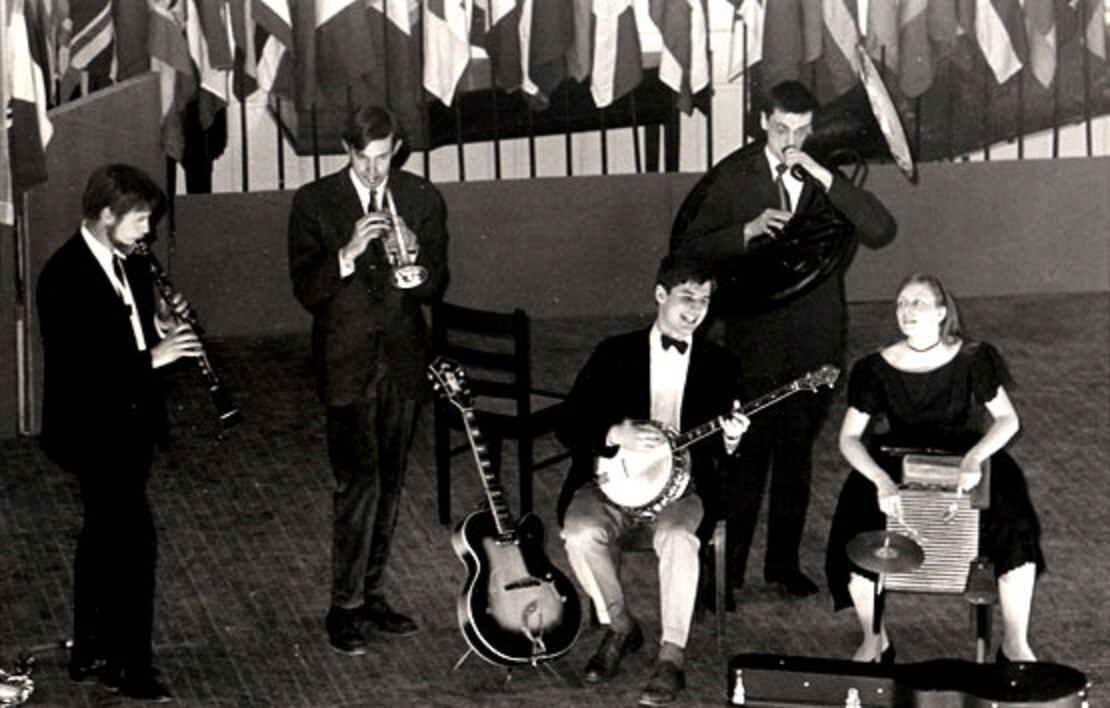
Mark eventually obtained a good banjo and Peter began rehearsing a small group consisting of cornet, clarinet, banjo, tuba, and washboard. (After learning some washboard tricks from an African drummer at the International House sessions Julie had become a very tasteful player.) Our first public appearance was at a Yale Band Pops concert in November, 1966, with Sammy Rimington on clarinet.
A few months after that Sammy moved back to England and Dick Cook took his place on clarinet and alto sax. Dick’s first first appearance with the band was a half-hour appearance on a public TV station in Maine, organized by Mark. We were billed as “Peter’s Pickled Peppers.” Some time later Peter arranged for us to play a freebie in Manhattan and billed us as “The Ansonia Washboard Band.” (“Ansonia” is the name of a small factory town in Connecticut, and Peter felt that would seem exotic to the folks in the big city.) Having established our identity as a washboard band, I then noticed the brand name on the washboard that Julie was using. The Tin Rainbow band had used a “Zinc King,” but ours proudly bore the inscription “Galvanized Washboard.” Taking advantage of the double meaning, we became known as the “Galvanized Washboard Band.”
On a visit to New Orleans in 1968 Peter met Tommy Sancton, a young clarinetist strongly influenced by George Lewis and Sammy Rimington. Although Peter urged him to come to Yale, Tommy chose Harvard instead. Between 1968 and 1970 (after Dick Cook’s return to England) we did a lot of commuting between New Haven and Cambridge, Massachusetts. Despite frequent automotive delays we made some good music and had some great times as a five-piece band.
In December of 1968 we gathered in the Yale Band rehearsal room to record our first LP. Howard Vidal was back in town after an extended absence, and we invited him to join us on trombone even though Tommy had never met him. I spliced two microphones together for the right channel and put a third one on the left channel of my trusty little Sony reel-to-reel tape recorder while Peter outlined his arrangements on a portable blackboard. Tommy wrote some fanciful liner notes and had a friend design a fine-looking album cover which we used for publicity posters for many subsequent performances. George Buck issued the LP the following spring as GHB-52.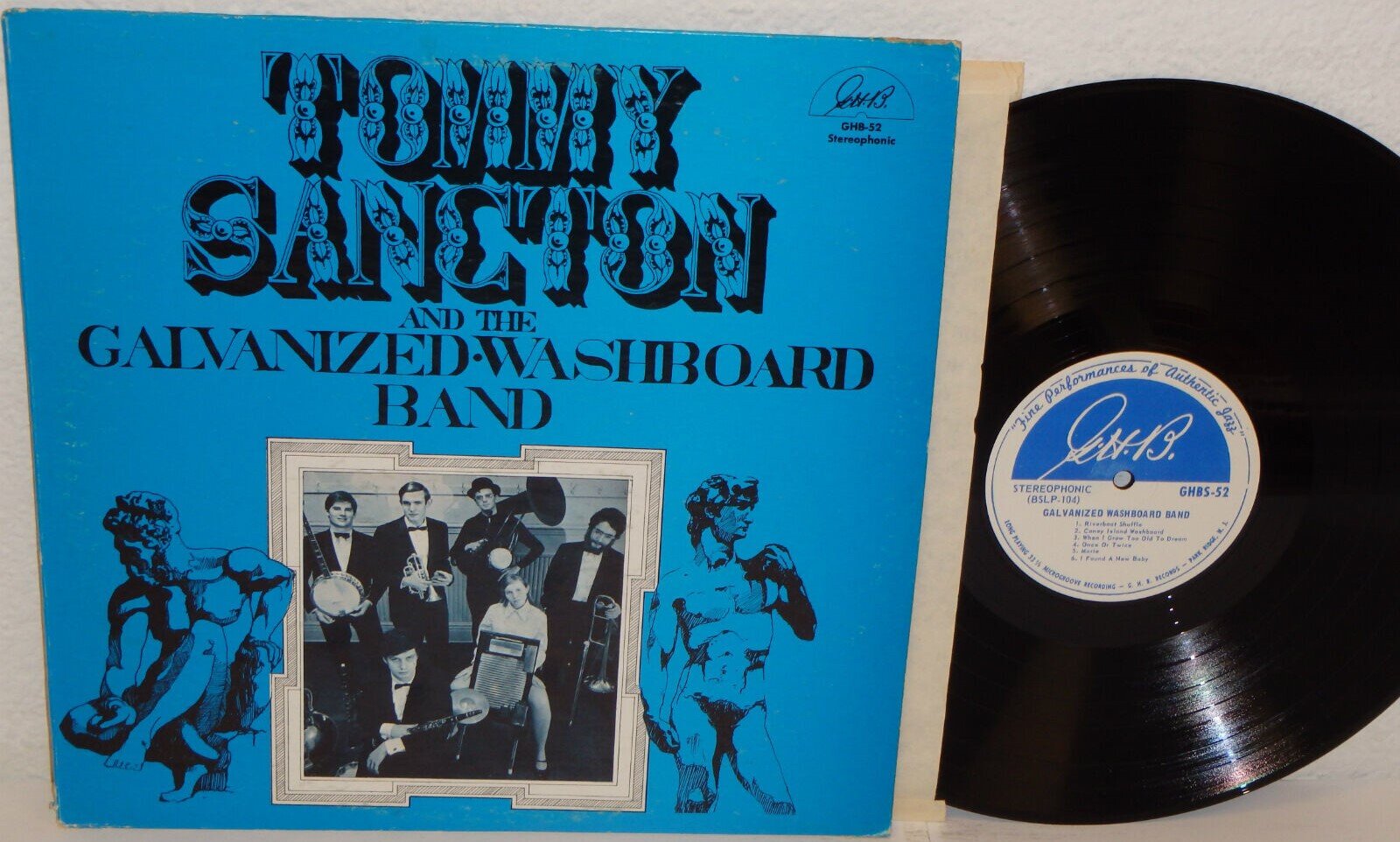
During the late 1960s Bill Sinclair and Noel had a regular Thursday night job at a great little bar in Hartford called the Rockinghorse. The group was called the “Nutmeg Jazz Band,” with Sammy Rimington on clarinet. Peter, Mark, and I used to drive up there occasionally to sit in or just to listen. Stan MacDonald and Tony Pringle often came down from Boston to sit in. The band members were only making ten bucks a night, but they chose to put $2 each into a kitty so that about once a month they could bring in Wild Bill Davison. The place was packed on those nights, and Davison was in magnificent form. Waitresses squealed with delight when Davison chased them with his cornet while soloing.
Around 1970 Mark Finks began devoting his full attention to finding work for the Galvanized Washboard Band. It was becoming difficult to get Tommy Sancton to make the long trip from Cambridge, and Peter Ecklund was spending more time in Boston and New York than in New Haven. Fred Vigorito was back in town after his hitch in the army, and the Rockinghorse was becoming a singles bar; the result was that Noel, Bill, and Fred began working more and more often with the washboard band.
For about a year we had a steady Thursday night gig at the Red Coach Grill, a steakhouse in West Haven. We would start each “Diamond Jim Brady Night” by parading into the dining area while playing “Hello My Baby”; then we would surround one table after another to play requests and schmooze with the customers. Later we would set up around the piano in the bar for another set or two. Mark somehow talked Kenny Davern into joining us occasionally. One night Kenny brought a very old but mint-condition Buescher soprano sax, with the lowest serial number that he had ever seen. Noel scraped the crud off the number on his own Buescher and found a number that was even lower. Another time Noel mentioned to Kenny that his favorite clarinet mouthpiece was wearing out. It was an obscure red plastic model, no longer available anywhere. Kenny played a few notes on it and said “I know just what you need.” The next time Kenny worked with us he handed Noel three new mouthpieces that were indeed just what he was looking for.
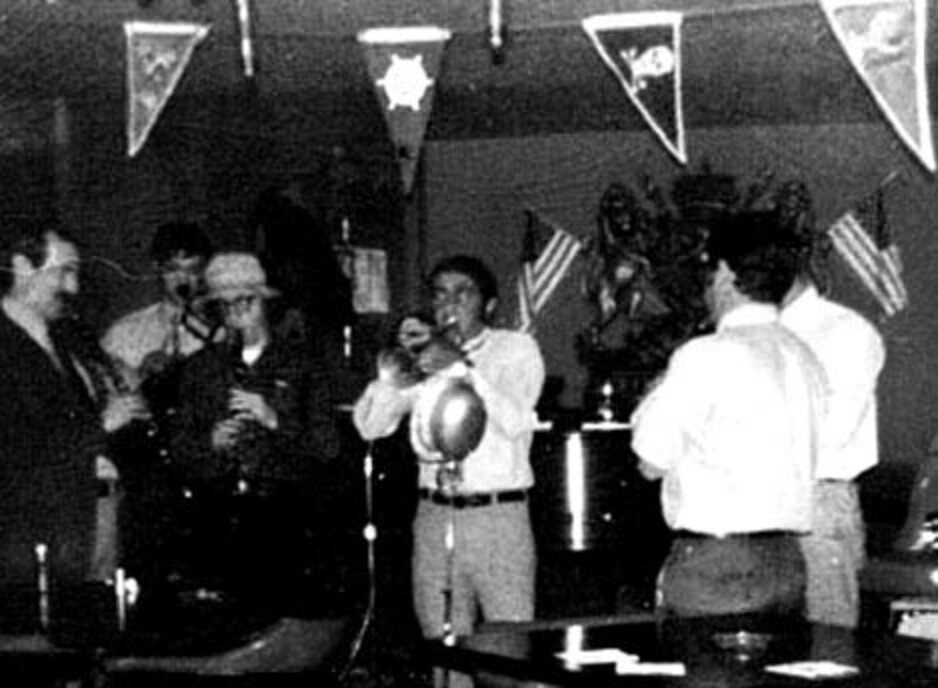
On another occasion both Kenny Davern and Woody Allen sat in with us at the Red Coach. Howard Cosell, the well-known sportscaster, came along for the ride and made learned comments about each tune that we played; he knew who wrote them and when, and what shows they were from, and who was in the shows. (Cosell mentions that evening briefly in his autobiography.) Woody was working on his Bananas movie at the time, and had not yet formed his New York band. He came to New Haven for two or three other jobs with us that year.
There were two active jazz clubs in Connecticut in those days. The Connecticut Traditional Jazz Club (known as “Conntrad”) leaned toward New Orleans style bands, usually from out of state. I remember hearing Kid Thomas Valentine, Albert Burbank, and Louis Nelson at one concert; they all greeted Tommy Sancton warmly and invited him to sit in, but the officers of the club would not allow it.
The other club was the “Dixieland Society of Connecticut,” which sponsored monthly concerts at Donat’s restaurant in Milford. That building has now been replaced with a Chase Bank. (And so the world ends; not with a whim, but with a banker!) DSC usually brought in one or two big names from New York to work with a group of local musicians which usually consisted of Noel Kaletsky on clarinet, Merrill Doucette on piano, Johnny Vine on drums, Doc Dunn, (a local dentist) on soprano sax, and Judge Herbert MacDonald on banjo. I remember hearing Roy Eldridge, Rex Stewart, Urbie Green, Conrad Janis, “Big Chief” Russell Moore, Max Kaminsky, and many others at DSC concerts; occasionally I was allowed to sit in.
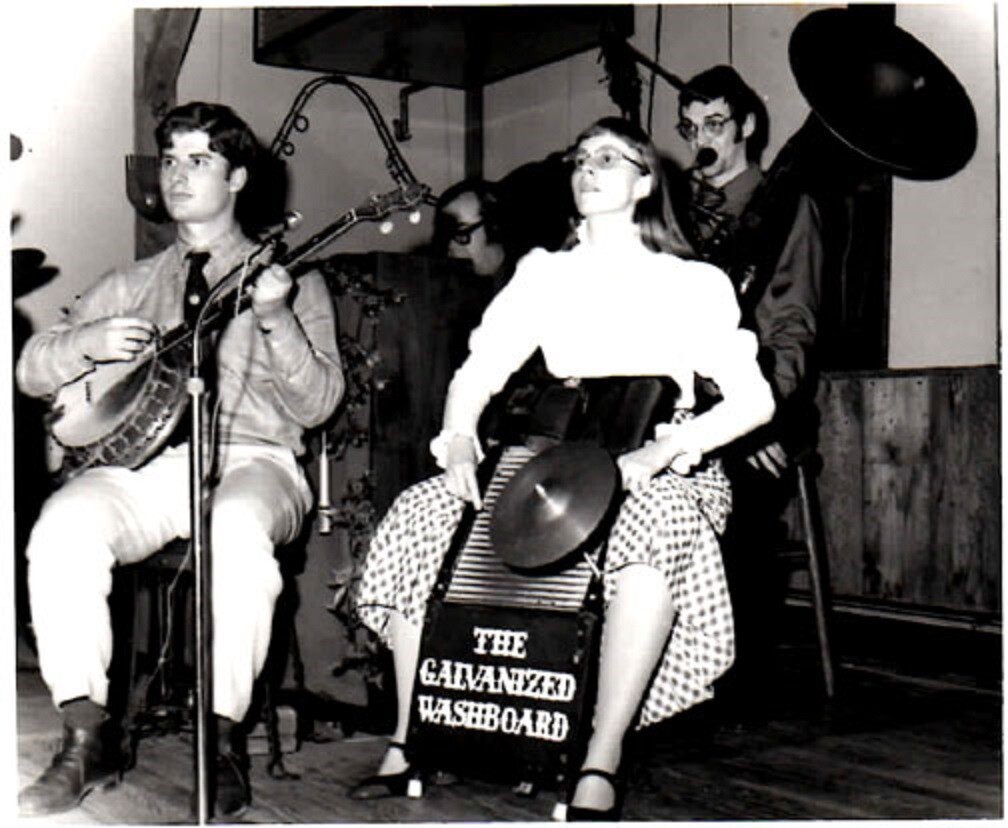
It was during our time at the Red Coach that Mark began talking about a new restaurant in Northford called the “Millpond Taverne,” owned and operated by Bud and Helen Thomas. We went in as a trio or quartet on a trial basis on some Sunday afternoons in 1970, without attracting much attention. We had tried Sunday afternoons before (at the Mermaid Tavern in Stratford) but as Doc Dunn put it, “people want to play with their lawnmowers on Sunday afternoons.”
Since Connecticut’s “blue laws” at the time required bars to close by 9 PM on Sundays, we could play only from 4:30 until 8:30. Nevertheless, Bud & Helen Thomas decided to go for it early in 1971. We brought Louis Nelson up from New Orleans and Tommy Benford from New York to kick off the regular Sunday series with a full seven-piece “Galvanized Jazz Band.” (Our recording with Nelson and Benford was made on that same weekend.) After that we went back to the trio format for a time, (piano, banjo, and tuba) with the band often outnumbering the audience. Bud and Helen were patient and generously allowed us to expand the group to four pieces (with washboard) and then five. Each time we expanded the band the crowd expanded too.
We all decided to go to New Orleans that spring for the Jazz & Heritage festival. Our good friends David Paquette and Howard Vidal were both living there at the time, although Howard was no longer playing trombone. There were jam sessions around the clock at Preservation Hall and several other French Quarter establishments, with traditional jazz enthusiasts from England, Sweden, France, Germany, and even California, all eager to sound just like their idols. Woody Allen was there with the very young and beautiful Diane Keaton. (He was then filming Sleeper.) On Friday afternoon of the Festival weekend Woody sat in with us on clarinet.
During that afternoon session George Wein telephoned to asked Woody if he would be willing to play the next night at the Municipal Auditorium as part of the festival. Woody asked who he would be working with, and George rattled off the names of several big stars who were on the program, including Bobby Hackett, Dizzy Gillespie, etc. “No, I’d rather not play with them,” said Woody, who was still reeling from a Tonight Show appearance with Doc Severinsen’s not-exactly-New-Orleans-style band. Wein asked Woody who he would want to play with. Pointing at us, Woody said, “These guys.” At every step in the subsequent negotiations Woody asked Mark Finks if it would be okay with us. We had to change some flight reservations to accommodate this new plan but we all agreed to do it. Mark recalled it this way a few years ago in an e-mail message:
As best I remember, it was at Economy Hall in the jazz museum at the Hotel Sonesta. That was where George Buck, Jr., showed up wearing a Hawaiian shirt with a camera slung around his neck. He came up to the platform and said, “Hey, do you guys record for anybody?” I dutifully replied, “Yes. We record for George H. Buck of Columbia, South Carolina.” George said, “Why, that’s funny; because I’m George Buck.” That was his way of introducing himself. The negotiations with George Wein to play for the Louis Armstrong tribute transpired a short while later. Woody kept his eyes on me while talking with George on the phone. He repeated the important points out loud and looked at me to see if they were OK with the band. Woody wanted to play with a compatible band, and he stuck to that. At length, it was agreed.
That night we attended the big Friday night Jazz festival concert. Word was out that Kid Ory was in town and had been rehearsing a band for that show, and was sounding better than ever. Sure enough, he did walk onto the stage and held his trombone for a few tunes while Bobby Hackett stood behind him playing trombone parts. The big surprise of the evening was the appearance of Tommy Sancton with a new band that he had assembled for the occasion; he called it the Black Eagle Jazz Band, with Tony Pringle on cornet, Eli Newberger on piano, “Big Jim” Klippert on trombone, and Chester Zardis on bass. I remember that they played some rags, including “Kinklets” and “Chrysanthemum.” The next day at the outdoor part of the festival I saw Mr. Zardis playing an E-flat sousaphone with a brass band and enjoyed a nice chat with him; his only complaint about Sancton’s band was that they played everything “too fas’!” Kid Ory was also there that afternoon, holding his trombone and giving interviews to reporters.
On Saturday night we showed up early at the Municipal Auditorium and spent some time with Woody Allen, eagerly planning what we would do for our first number, our second, and so on until finally Woody shyly pointed out that there might not be a fourth or fifth tune. While waiting backstage we had nice chats with Wendell Eugene (who later came to Connecticut a few times to work with us) and with Danny Barker. Mr. Barker told us about needing old instruments for a youth band he was starting at the Fairview Baptist Church. After returning to Connecticut I sent him a couple of trombones that I found at garage sales; eventually I received a thank-you note with a nice photo of the band. Some years later I was told that one of the little kids in the trumpet section in that photo was Wynton Marsalis and that some of the others went on to form the Dirty Dozen Jazz Band.
When our moment finally came, we went onstage and did our best. In addition to Woody we had Noel Kaletsky on sax, Fred Vigorito on cornet, Dave Donahoe (a British trombonist we had just met), Bill Sinclair on piano, Julie on washboard, and yours truly on an old tuba. While we were on, Dizzy Gillespie entertained my year-and-a-half-old daughter backstage by tooting his trumpet into her belly. The concert was reviewed in Downbeat Magazine, where we were described as “a cut above Ruby Red’s.”
By then Mark Finks had become the Big Cheese in the Dixieland Society. One of the first concerts that he organized featured Wild Bill Davison, Herb Hall, Benny Morton, Red Richards and Buzzy Drootin. After that he began using big-name guest artists such as Bobby Hackett and George Masso with the Galvanized Jazz Band. Teddy Wilson was our featured guest at one concert on Nov. 22, 1971.
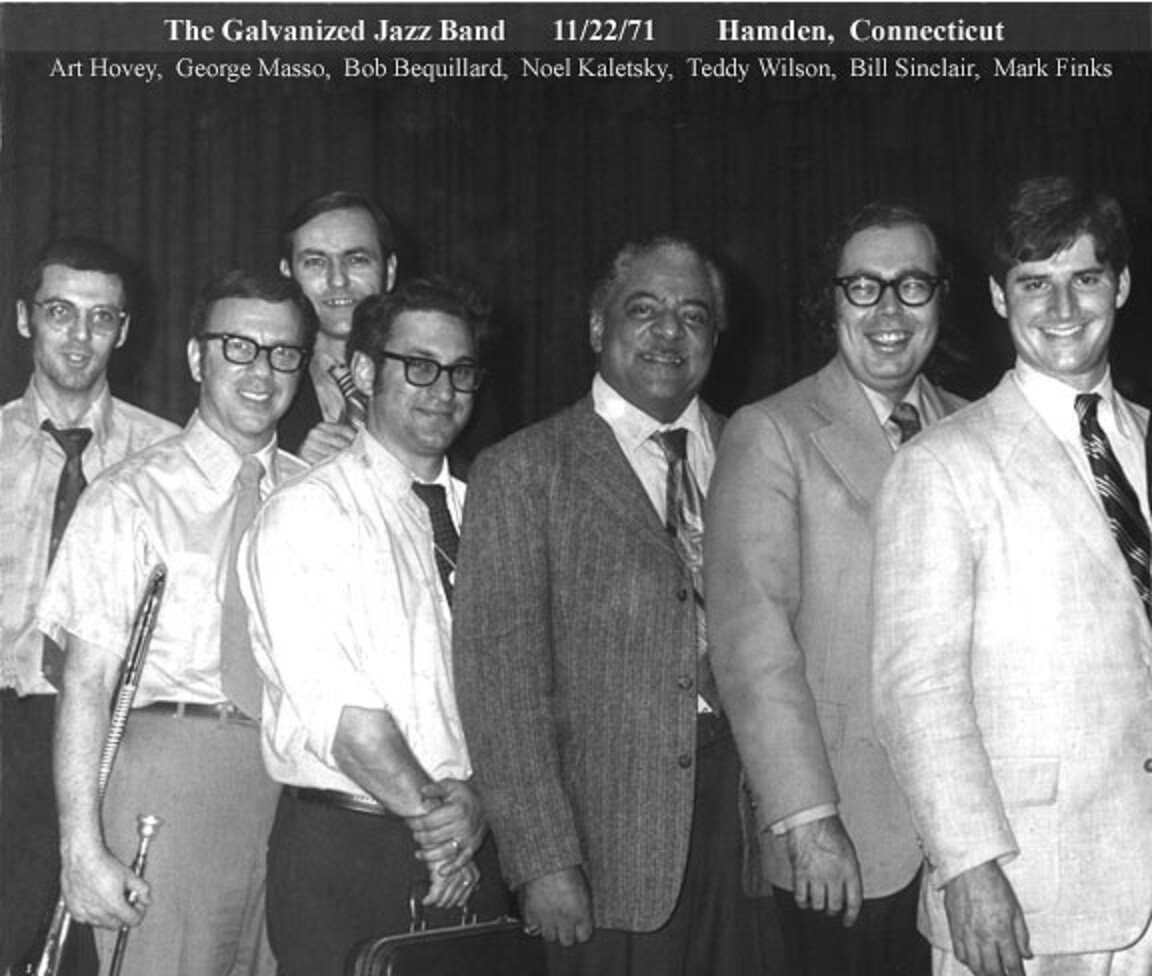
At another of those concerts Woody Allen was the main attraction; he sat quietly and played his clarinet with his hat on for the whole evening, as was his custom. At the beginning of the third set an irate customer demanded to know “when is Woody Herman going to show up?”
Art Hovey’s history of the Galvanized Jazz Band will be continued.
Art Hovey plays bass and tuba with the Galvanized Jazz Band. For more please visit galvanizedjazz.com
.





